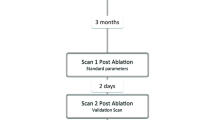Abstract
Cardiac magnetic resonance imaging (CMRI) of the left atrium following catheter ablation can detect lesions with delayed enhancement (DE) and more recently with T2-weighted enhancement (T2W). We know that catheter stability, tissue contact force and RF duration are determinants of lesion formation and may be operator-dependent. The Hansen Robotic System (Hansen, Mountain View, CA, USA) permits accurate titration of contact force while maintaining a stable catheter position. Here, we sought to compare atrial injury following manual or robotic catheter ablation by quantifying tissue necrosis with DE and tissue edema with T2W enhancement on CMRI. Twelve patients (mean age 54±15.4) with paroxysmal atrial fibrillation (PAF) undergoing first ablation were recruited to undergo either manual (n=6) or robotic (n=6) approach. Following confirmed pulmonary vein isolation (PVI), 24 pairs of PVs were imaged. DE, T2W, and anatomical imaging sequences were performed pre- and immediately post- wide area circumferential ablation. A semi-automatic 3D method [Knowles et al. IEEE Trans. Biomed. Eng. 2010] was used for visualizing and quantifying tissue injury. Atrial surface models were derived from the anatomical MRI data and registered to DE or T2W MR scans. The maximum intensity projection values were computed onto the atrial surfaces with subsequent color coding (see the figure for an example taken from one of the robotic cases; green=min to red=max). The percentages of PV antral circumferential enhancement on the surfaces were quantified for each of DE (irreversible injury), T2W (reversible injury) and combined DE & T2W. Robotic ablation resulted in a greater circumferential lesion extent as assessed by DE and T2W. In both groups, areas of T2W (edema) not only overlapped with areas of DE but also filled in gaps between areas of DE producing in combination near complete circumferential lesions around all PVs. Combination of T2W and DE conferred a statistically significant higher % encirclement in the robotic series (92%) versus standard navigation (71%) (p=0.007). A non-significant higher mean ratio of DE to (T2+DE) of 0.75±0.18 versus 0.61±0.30 was observed in the robotic arm (p=0.20). Calculated mean energy delivered was 84.2kJ versus 79.6kJ in the robotic and standard navigation groups (p=0.82), respectively. In comparison to manual ablation, robotic LA ablation achieves more tissue necrosis and a greater degree of PV antral encirclement. This may be a function of improved stability and contact force information.
Access this chapter
Tax calculation will be finalised at checkout
Purchases are for personal use only
Similar content being viewed by others
Author information
Authors and Affiliations
Editor information
Editors and Affiliations
Rights and permissions
Copyright information
© 2011 Springer-Verlag Berlin Heidelberg
About this paper
Cite this paper
Arujuna, A. et al. (2011). Are Robotic-Assisted Catheter Ablation Lesions Different from Standard Catheter Ablation in Paroxysmal AF Patients? : Novel CMRI Findings Made Possible with Semi-automatic 3-D Visualisation. In: Metaxas, D.N., Axel, L. (eds) Functional Imaging and Modeling of the Heart. FIMH 2011. Lecture Notes in Computer Science, vol 6666. Springer, Berlin, Heidelberg. https://doi.org/10.1007/978-3-642-21028-0_41
Download citation
DOI: https://doi.org/10.1007/978-3-642-21028-0_41
Publisher Name: Springer, Berlin, Heidelberg
Print ISBN: 978-3-642-21027-3
Online ISBN: 978-3-642-21028-0
eBook Packages: Computer ScienceComputer Science (R0)




